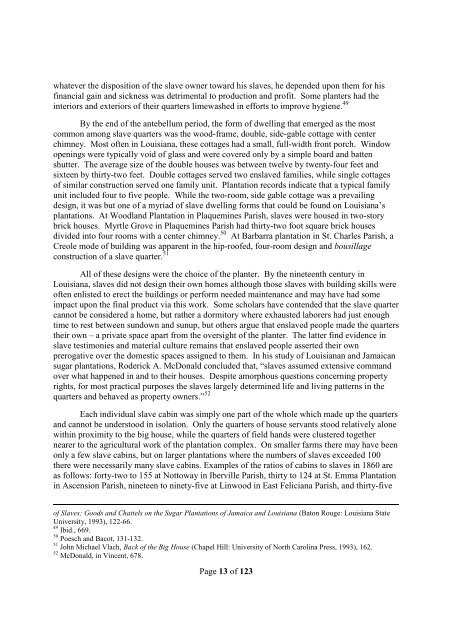The African American Experience in Louisiana
The_African_American_Experience_in_Louisiana
The_African_American_Experience_in_Louisiana
- No tags were found...
You also want an ePaper? Increase the reach of your titles
YUMPU automatically turns print PDFs into web optimized ePapers that Google loves.
whatever the disposition of the slave owner toward his slaves, he depended upon them for his<br />
f<strong>in</strong>ancial ga<strong>in</strong> and sickness was detrimental to production and profit. Some planters had the<br />
<strong>in</strong>teriors and exteriors of their quarters limewashed <strong>in</strong> efforts to improve hygiene. 49<br />
By the end of the antebellum period, the form of dwell<strong>in</strong>g that emerged as the most<br />
common among slave quarters was the wood-frame, double, side-gable cottage with center<br />
chimney. Most often <strong>in</strong> <strong>Louisiana</strong>, these cottages had a small, full-width front porch. W<strong>in</strong>dow<br />
open<strong>in</strong>gs were typically void of glass and were covered only by a simple board and batten<br />
shutter. <strong>The</strong> average size of the double houses was between twelve by twenty-four feet and<br />
sixteen by thirty-two feet. Double cottages served two enslaved families, while s<strong>in</strong>gle cottages<br />
of similar construction served one family unit. Plantation records <strong>in</strong>dicate that a typical family<br />
unit <strong>in</strong>cluded four to five people. While the two-room, side gable cottage was a prevail<strong>in</strong>g<br />
design, it was but one of a myriad of slave dwell<strong>in</strong>g forms that could be found on <strong>Louisiana</strong>’s<br />
plantations. At Woodland Plantation <strong>in</strong> Plaquem<strong>in</strong>es Parish, slaves were housed <strong>in</strong> two-story<br />
brick houses. Myrtle Grove <strong>in</strong> Plaquem<strong>in</strong>es Parish had thirty-two foot square brick houses<br />
divided <strong>in</strong>to four rooms with a center chimney. 50 At Barbarra plantation <strong>in</strong> St. Charles Parish, a<br />
Creole mode of build<strong>in</strong>g was apparent <strong>in</strong> the hip-roofed, four-room design and bousillage<br />
construction of a slave quarter. 51<br />
All of these designs were the choice of the planter. By the n<strong>in</strong>eteenth century <strong>in</strong><br />
<strong>Louisiana</strong>, slaves did not design their own homes although those slaves with build<strong>in</strong>g skills were<br />
often enlisted to erect the build<strong>in</strong>gs or perform needed ma<strong>in</strong>tenance and may have had some<br />
impact upon the f<strong>in</strong>al product via this work. Some scholars have contended that the slave quarter<br />
cannot be considered a home, but rather a dormitory where exhausted laborers had just enough<br />
time to rest between sundown and sunup, but others argue that enslaved people made the quarters<br />
their own – a private space apart from the oversight of the planter. <strong>The</strong> latter f<strong>in</strong>d evidence <strong>in</strong><br />
slave testimonies and material culture rema<strong>in</strong>s that enslaved people asserted their own<br />
prerogative over the domestic spaces assigned to them. In his study of <strong>Louisiana</strong>n and Jamaican<br />
sugar plantations, Roderick A. McDonald concluded that, “slaves assumed extensive command<br />
over what happened <strong>in</strong> and to their houses. Despite amorphous questions concern<strong>in</strong>g property<br />
rights, for most practical purposes the slaves largely determ<strong>in</strong>ed life and liv<strong>in</strong>g patterns <strong>in</strong> the<br />
quarters and behaved as property owners.” 52<br />
Each <strong>in</strong>dividual slave cab<strong>in</strong> was simply one part of the whole which made up the quarters<br />
and cannot be understood <strong>in</strong> isolation. Only the quarters of house servants stood relatively alone<br />
with<strong>in</strong> proximity to the big house, while the quarters of field hands were clustered together<br />
nearer to the agricultural work of the plantation complex. On smaller farms there may have been<br />
only a few slave cab<strong>in</strong>s, but on larger plantations where the numbers of slaves exceeded 100<br />
there were necessarily many slave cab<strong>in</strong>s. Examples of the ratios of cab<strong>in</strong>s to slaves <strong>in</strong> 1860 are<br />
as follows: forty-two to 155 at Nottoway <strong>in</strong> Iberville Parish, thirty to 124 at St. Emma Plantation<br />
<strong>in</strong> Ascension Parish, n<strong>in</strong>eteen to n<strong>in</strong>ety-five at L<strong>in</strong>wood <strong>in</strong> East Feliciana Parish, and thirty-five<br />
of Slaves: Goods and Chattels on the Sugar Plantations of Jamaica and <strong>Louisiana</strong> (Baton Rouge: <strong>Louisiana</strong> State<br />
University, 1993), 122-66.<br />
49 Ibid., 669.<br />
50 Poesch and Bacot, 131-132.<br />
51 John Michael Vlach, Back of the Big House (Chapel Hill: University of North Carol<strong>in</strong>a Press, 1993), 162.<br />
52 McDonald, <strong>in</strong> V<strong>in</strong>cent, 678.<br />
Page 13 of 123


